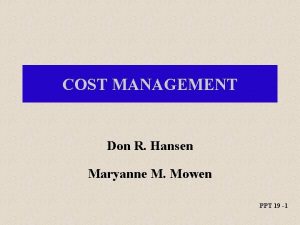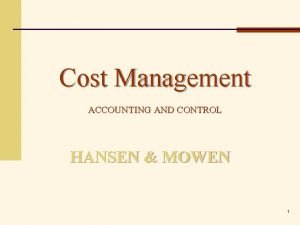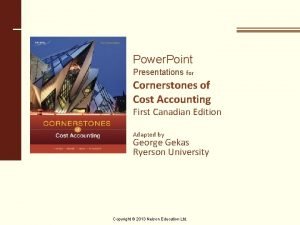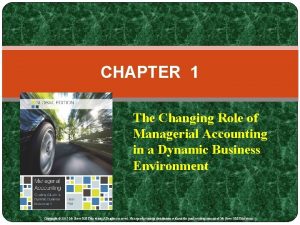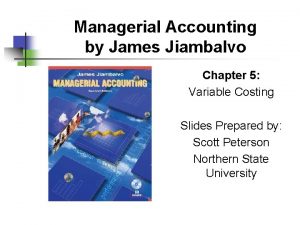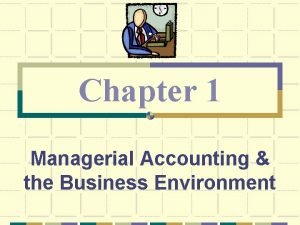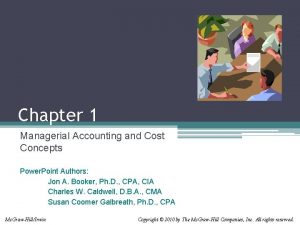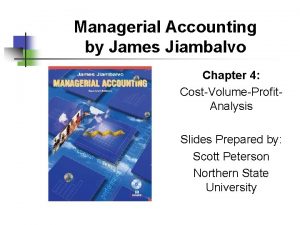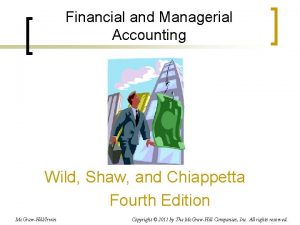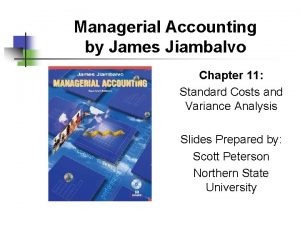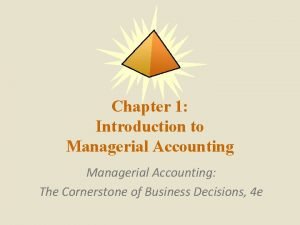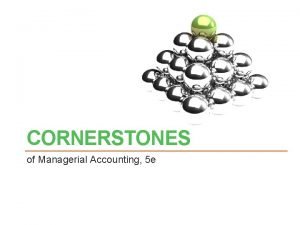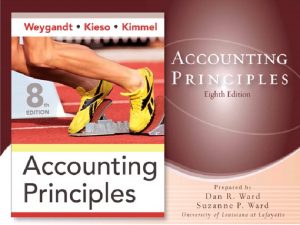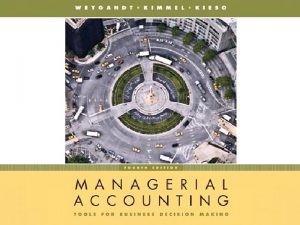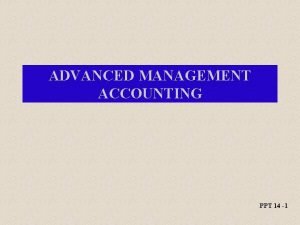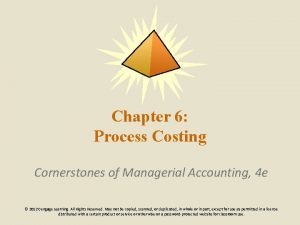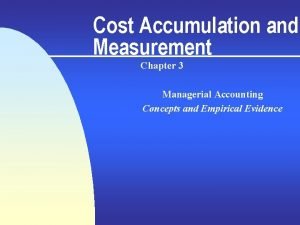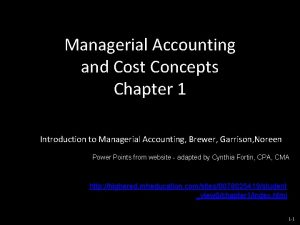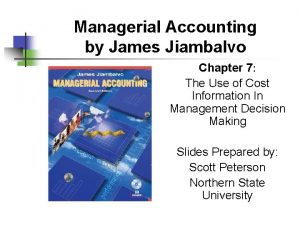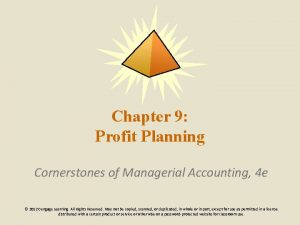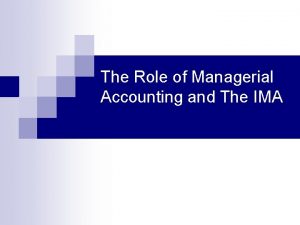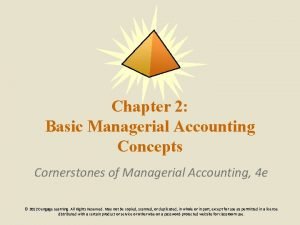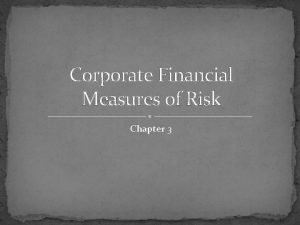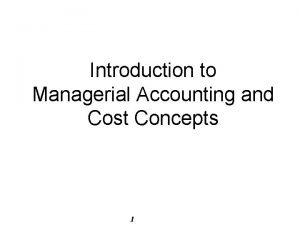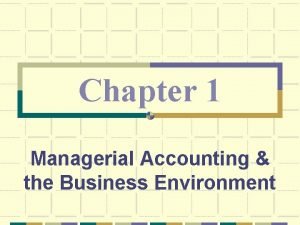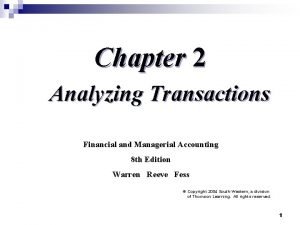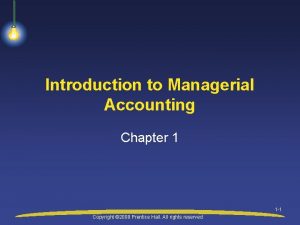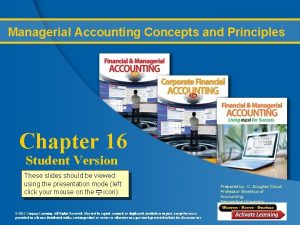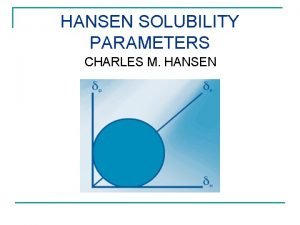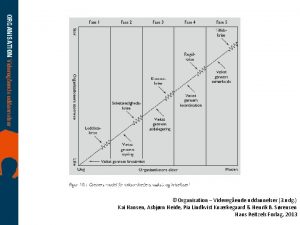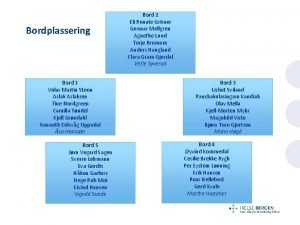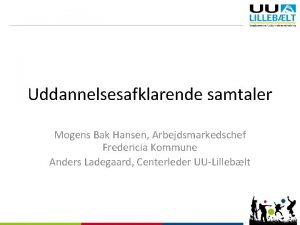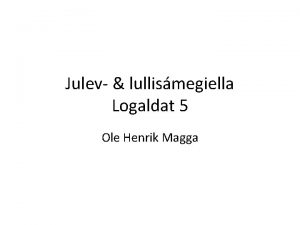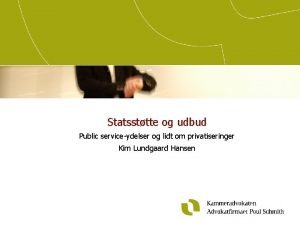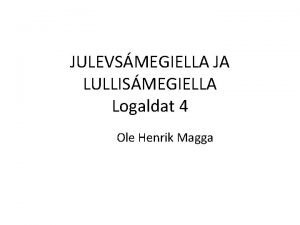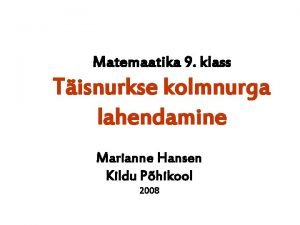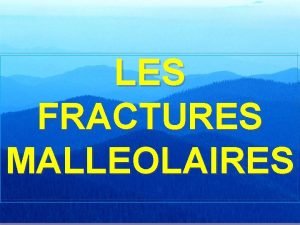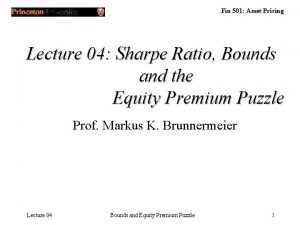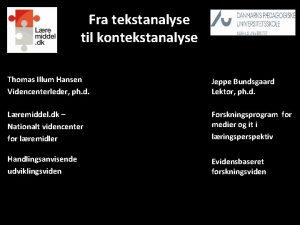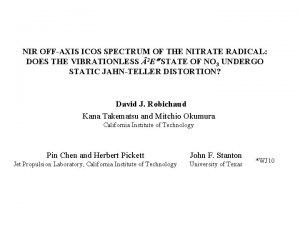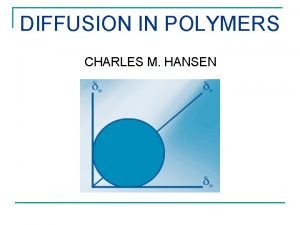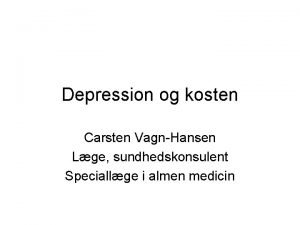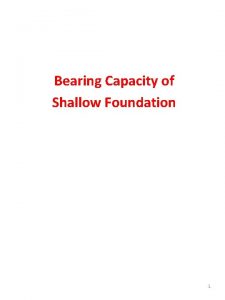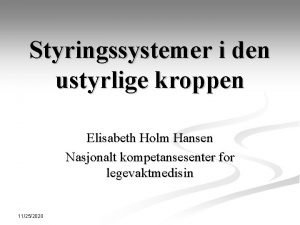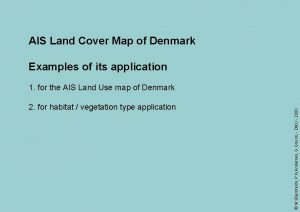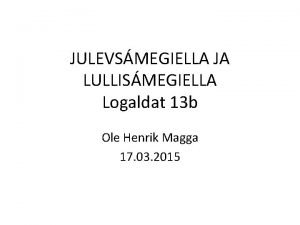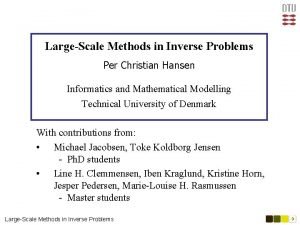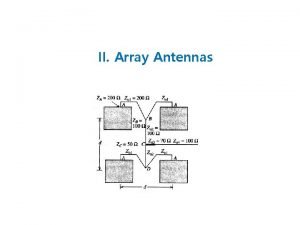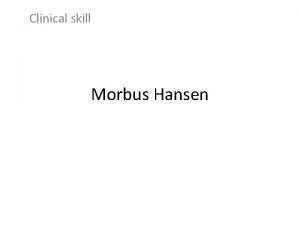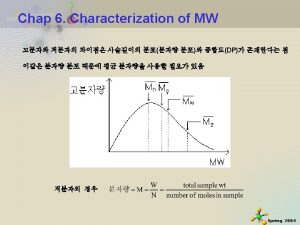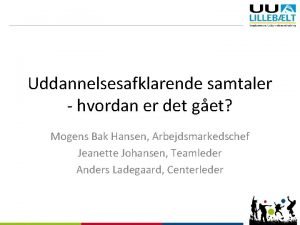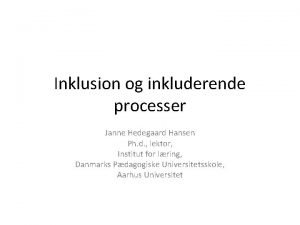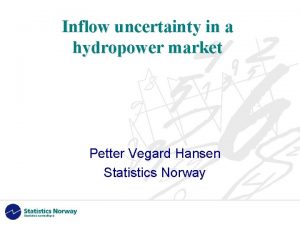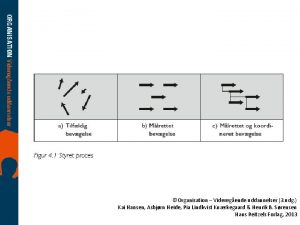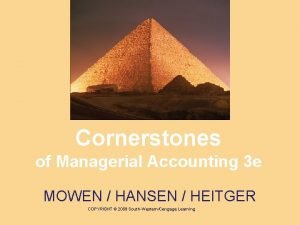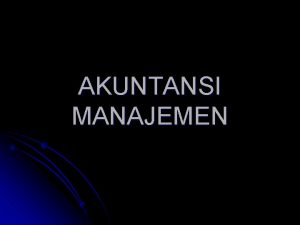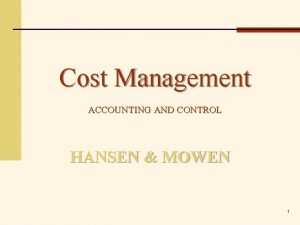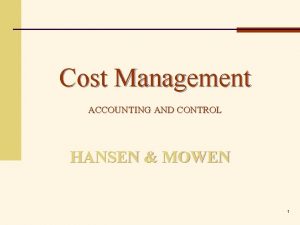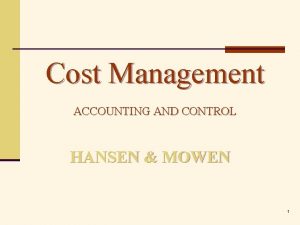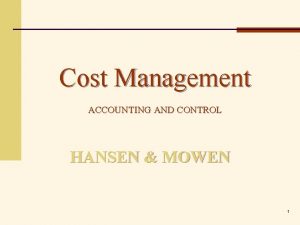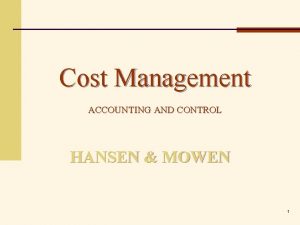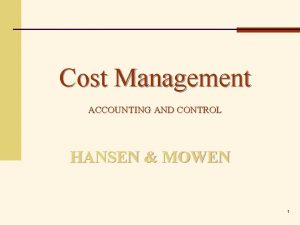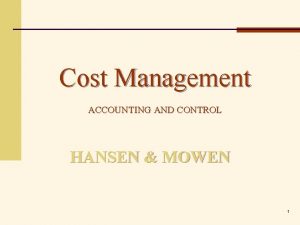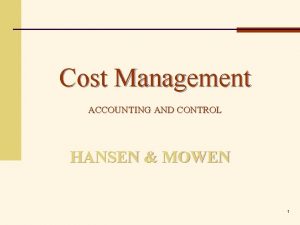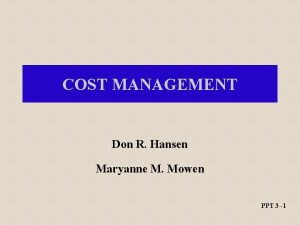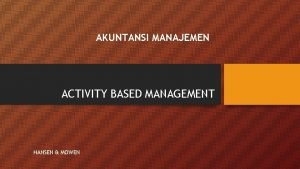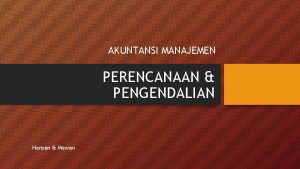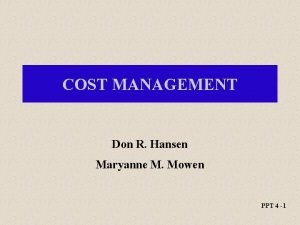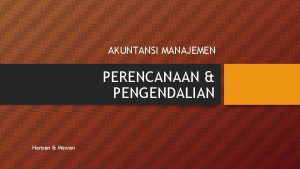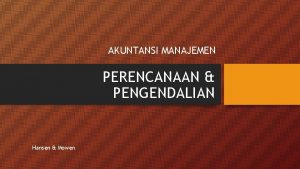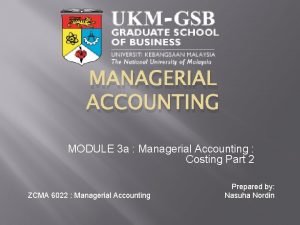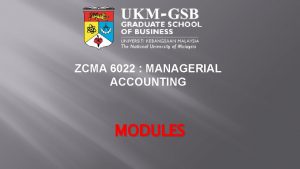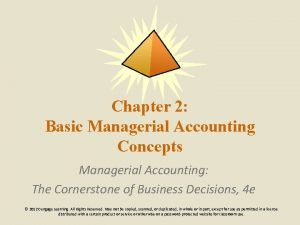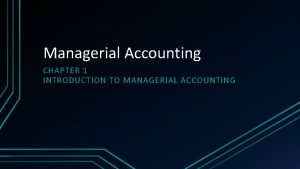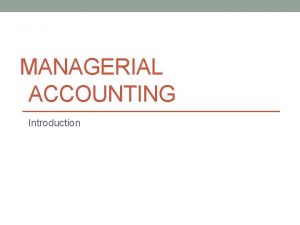Cornerstones of Managerial Accounting 3 e MOWEN HANSEN
















































































- Slides: 80

Cornerstones of Managerial Accounting 3 e MOWEN / HANSEN / HEITGER COPYRIGHT © 2009 South-Western/Cengage Learning

Chapter Eight Absorption and Variable Costing, and Inventory Management

Learning Objectives 1. Explain the difference between absorption and variable costing earning of capital investment decisions, and distinguish between independent and mutually exclusive capital investment decisions. 2. Prepare segmented income statements. 3. Discuss inventory management under the economic order quantity and just-in-time (JIT) models. 3

OBJECTIVE 1 Explain the difference between absorption and variable costing.

Absorption Costing Income Statement • Assigns all manufacturing costs to the product – – Direct Materials Direct Labor Variable Overhead Fixed Overhead • Fixed overhead is applied to the product using a predetermined overhead rate • Required by generally accepted accounting principles (GAAP) for external reporting 5

Variable Costing Income Statement • Assigns only variable manufacturing costs to the product – Direct Materials – Direct Labor – Variable Overhead • Fixed overhead is treated as a period expense 6

Cornerstone 8 -1 HOW TO Compute Inventory Cost under Absorption Costing 7

Example Information: Units in beginning inventory Units produced Units sold ($300 per unit) Variable costs per unit: Direct materials Direct labor Variable overhead Fixed costs: Fixed overhead per unit produced Fixed selling and administrative ---10, 000 8, 000 $ 50 100 50 25 100, 000 8

Example Required: 1. How many units are in ending inventory? 2. Using absorption costing, calculate the perunit product cost. 3. What is the value of ending inventory? 9

Example Units ending = beginning + inventory 0 = = + Units – produced 10, 000 2, 000 – Units sold 8, 000

Absorption Costing Direct Materials $ 50 Per unit

Absorption Costing Direct Materials Direct Labor Variable overhead Fixed overhead Unit product cost $ 50 100 50 25 $225 Value of ending inventory = 2, 000 x $225 = $450, 000

Cornerstone 8 -2 HOW TO Compute Inventory Cost under Variable Costing 13

Example Information: Units in beginning inventory Units produced Units sold ($300 per unit) Variable costs per unit: Direct materials Direct labor Variable overhead Fixed costs: Fixed overhead per unit produced Fixed selling and administrative ---10, 000 8, 000 $ 50 100 50 25 100, 000

Example Required: 1. How many units are in ending inventory? 2. Using variable costing, calculate the per-unit product cost. 3. What is the value of ending inventory? 15

Example Units ending = beginning + inventory 0 = = + Units – produced 10, 000 2, 000 – Units sold 8, 000

Variable Costing Direct Materials $ 50 Direct Labor Variable overhead Unit product cost 100 50 $200 Only variable costs

Variable Costing Direct Materials $ 50 Direct Labor Variable overhead Unit product cost 100 50 $200 Value of ending inventory = 2, 000 x $200 = $400, 000 When inventory on hand exists, variable costing results in lower ending inventory than absorption costing

Absorption and Variable Costing Absorption Costing Unit Cost DM DM DL DL Var OH Variable Costing Unit Cost Fixed OH Absorption Costing included Fixed Overhead in Unit Cost, Variable Costing does not.

Cornerstone 8 -3 HOW TO Prepare an Absorption-Costing Income Statement 20

Example Information: Units in beginning inventory Units produced Units sold ($300 per unit) Variable costs per unit: Direct materials Direct labor Variable overhead Fixed costs: Fixed overhead per unit produced Fixed selling and administrative ---10, 000 8, 000 $ 50 100 50 25 100, 000

Example Required: 1. Calculate the cost of goods sold under absorption costing. 2. Prepare an income statement using absorption costing. 22

Example Absorption unit product cost Cost of = goods sold = x $225 $50 + $100 + $50 + $25 Units sold

Example Cost of = goods sold Absorption unit product cost x $225 x = = Units sold 8, 000 $1, 800, 000

Fairchild Company Absorption-Costing Income Statement Sales ($300 x 8, 000) Less: Cost of goods sold Gross Margin $2, 400, 000 1, 800, 000 $ 600, 000 Less: Selling and administrative expenses 100, 000 Fixed selling and administrative costs

Fairchild Company Absorption-Costing Income Statement Sales ($300 x 8, 000) Less: Cost of goods sold Gross Margin Less: Selling and administrative expenses Net Income $2, 400, 000 1, 800, 000 $ 600, 000 100, 000 $ 500, 000

Cornerstone 8 -4 HOW TO Prepare a Variable-Costing Income Statement 27

Example Information: Units in beginning inventory Units produced Units sold ($300 per unit) Variable costs per unit: Direct materials Direct labor Variable overhead Fixed costs: Fixed overhead per unit produced Fixed selling and administrative ---10, 000 8, 000 $ 50 100 50 25 100, 000

Example Required: 1. Calculate the cost of goods sold under variable costing. 2. Prepare an income statement using variable costing. 29

Example Cost of = goods sold Variable unit product cost = x $200 $50 + $100 + $50 Units sold

Example Cost of = goods sold Variable unit product cost $200 = = x x Units sold 8, 000 $1, 600, 000

Fairchild Company Variable-Costing Income Statement Sales ($300 x 8, 000) $2, 400, 000 Less variable expenses: Variable cost of goods sold Contribution margin 1, 600, 000 $ 800, 000 Only variable costs are subtracted. Subtotal is called Contribution Margin instead of Gross Margin

Fairchild Company Variable-Costing Income Statement Sales ($300 x 8, 000) $2, 400, 000 Less variable expenses: Variable cost of goods sold Contribution margin 1, 600, 000 $ 800, 000 Less fixed expenses: Fixed overhead $250, 000 $25 x 10, 000 Fixed overhead for all the units produced. None of the fixed overhead is carried in inventory.

Fairchild Company Variable-Costing Income Statement Sales ($300 x 8, 000) $2, 400, 000 Less variable expenses: Variable cost of goods sold Contribution margin 1, 600, 000 $ 800, 000 Less fixed expenses: Fixed overhead $250, 000 Fixed selling and administrative 100, 000 Net Income 350, 000 $ 450, 000

Production, Sales, and Income Relationships If Then 1. Production > Sales Absorption Income > Variable Income 2. Production < Sales Absorption Income < Variable Income 3. Production = Sales Absorption Income = Variable Income

OBJECTIVE 2 Prepare segmented income statements.

Segmented Income Statements • Segment is a subunit of a company – – Divisions Departments Product lines Customer classes • Fixed expenses are broken down into two categories: – Direct fixed expenses • Directly traceable to a segment – Common fixed expenses • Jointly caused by two or more segments 37

Segment Margin Sales – Variable Cost of Goods Sold – Variable Selling Expense Contribution Margin – Direct fixed overhead – Direct selling and administrative Segment Margin

Cornerstone 8 -5 HOW TO Prepare a Segmented Income Statement 39

Example Information: Sales Variable cost of goods sold Direct fixed overhead MP 3 Players $400, 000 200, 000 30, 000 DVD Players $290, 000 150, 000 20, 000 • Sales commissions, 5% of sales • Direct fixed selling and administrative expense estimated: ◦ $10, 000 for the MP 3 line ◦ $15, 000 for the DVD line • Common fixed overhead estimated, $100, 000 • Common selling and administrative estimated, $20, 000

Example Required: Prepare a segmented income statement for Audiomatronics Inc. for the coming year, using variable costing. 41

Audiomatronics Inc. Segmented Income Statement For the Coming Year MP 3 Players Sales $400, 000 Variable cost of goods sold (200, 000) Variable selling expense (20, 000) DVD Players $290, 000 (150, 000) Sales commissions = 5% of Sales 5% x $400, 000 Total $690, 000 (350, 000)

Audiomatronics Inc. Segmented Income Statement For the Coming Year MP 3 Players Sales $400, 000 Variable cost of goods sold (200, 000) Variable selling expense (20, 000) DVD Players $290, 000 (150, 000) (14, 500) 5% x $290, 000 Total $690, 000 (350, 000)

Audiomatronics Inc. Segmented Income Statement For the Coming Year MP 3 Players Sales $400, 000 Variable cost of goods sold (200, 000) Variable selling expense (20, 000) Contribution Margin $180, 000 Less direct fixed expenses: Direct fixed overhead (30, 000) (10, 000) Direct selling & admin. Segment margin $140, 000 DVD Players Total $290, 000 (150, 000) (14, 500) $125, 500 $690, 000 (350, 000) (34, 500) $305, 500 (20, 000) (15, 000) $ 90, 500 (50, 000) (25, 000) $230, 500 Segment margin reflects only those costs directly related to the operation of the segment. Common costs are not included in the segment margin.

Audiomatronics Inc. Segmented Income Statement For the Coming Year MP 3 Players Sales $400, 000 Variable cost of goods sold (200, 000) Variable selling expense (20, 000) Contribution Margin $180, 000 Less direct fixed expenses: Direct fixed overhead (30, 000) (10, 000) Direct selling & admin. Segment margin $140, 000 Less common fixed expenses: Common fixed overhead Common selling & admin. Operating Income DVD Players Total $290, 000 (150, 000) (14, 500) $125, 500 $690, 000 (350, 000) (34, 500) $305, 500 (20, 000) (15, 000) $ 90, 500 (50, 000) (25, 000) $230, 500 (100, 000) (20, 000) $110, 500

OBJECTIVE 3 Discuss inventory management under the economic order quantity and just-in-time (JIT) models.

Ordering Costs • Costs of placing and receiving an order • Examples: – Order processing costs – Cost of insurance for shipment – Unloading costs

Carrying Costs • Costs of carrying inventory • Examples: – Insurance – Inventory taxes – Obsolescence – Opportunity cost of funds ties up in inventory, handling costs, and storage space 48

Stockout Costs • Occur when demand is not known • Costs of not having: – Product available when demanded by a customer – Raw materials available when needed for production • Examples: – Lost sales – Costs of expediting – Costs of interrupted production 49

Traditional Reasons for Carrying Inventory • To balance ordering or setup costs and carrying costs • To satisfy customer demand • To avoid shutting down manufacturing facilities because of: – – Machine failure Defective parts Unavailable parts Late delivery of parts • To buffer against unreliable production processes • To take advantage of discounts • To hedge against future price increases

Cornerstone 8 -6 HOW TO Calculate Ordering Cost, and Total Inventory-Related Cost 51

Example Information: • Mall-o-Cars Inc. uses part X 7 B to repair water pumps – 10, 000 units of part X 7 B are used each year – Currently purchased in lots of 1, 000 units – Cost of $25 to place an order – Carrying cost is $2 per part per year

Example Required: 1. How many orders for Part X 7 B does Mallo-Cars place per year? 2. What is the total ordering cost of Part X 7 B per year? 3. What is the total carrying cost of Part X 7 B per year? 4. What is the total cost of Mall-o-Car’s inventory policy for Part X 7 B per year?

Example 1. Number of orders = Annual number of units used ÷ Number of units in an order = 10, 000 ÷ 1, 000 = 10 orders per year

Example 2. Total ordering cost = Number of orders × Cost per order = 10 orders × $25 = $250

Example 3. Total carrying cost = Average number of units in inventory × Cost of carrying one unit in inventory = (1, 000/2) × $2 = $1, 000

Example 4. Total inventory-related cost = Total ordering cost + Total carrying cost = $250 + $1, 000 = $1, 250

Economic Order Quantity (EOQ): The Traditional Inventory Model • • • Number of units in the optimal size order Minimizes total inventory-related costs Formula: 2 x CO x D/CC Cost of placing one order

Economic Order Quantity (EOQ): The Traditional Inventory Model • • • Number of units in the optimal size order Minimizes total inventory-related costs Formula: 2 x CO x D/CC Annual demand in units

Economic Order Quantity (EOQ): The Traditional Inventory Model • • • Number of units in the optimal size order Minimizes total inventory-related costs Formula: 2 x CO x D/CC Cost of carrying one unit in inventory

Cornerstone 8 -7 HOW TO Calculate the EOQ 61

Example Information: • Mall-o-Cars Inc. uses Part X 7 B to repair water pumps – 10, 000 units of Part X 7 B are used each year – Currently purchased in lots of 1, 000 units – Cost of $25 to place an order – Carrying cost is $2 per part per year

Example Required: 1. What is the EOQ for Part X 7 B? 2. How many orders per year for Part X 7 B will Mall-o-Cars place under the EOQ policy? 3. What is the total annual ordering cost of Part X 7 B for a year under the EOQ policy? 4. What is the total annual carrying cost of Part X 7 B per year under the EOQ policy? 5. What is the total annual inventory-related cost for Part X 7 B under the EOQ?

Example 1. Economic Order Quantity (EOQ) = 2 x 10, 000 x $25/$2 = 500, 000/2 = 500 units

Example 2. Number of orders = Annual number of units used ÷ Number of units in an order = 10, 000 ÷ 500 = 20 orders per year

Example 3. Total ordering cost = Number of orders × Cost per order = 20 orders × $25 = $500

Example 4. Total carrying cost = Average number of units in inventory × = (500/2) × $2 = $500 Cost of carrying one unit in inventory

Example 5. Total inventory-related cost = Total ordering cost = $500 + + = $1, 000 Total carrying cost $500

Reorder Point • Point in time when a new order should be placed • Function of: – EOQ – Lead time • Time required to received the economic order quantity once an order is place or a setup is started – Rate at which inventory is used Reorder point = Rate of usage × Lead time

Cornerstone 8 -8 HOW TO Calculate the Reorder Point When Usage is Known with Certainty 70

Example Information: • Mall-o-Cars Inc. uses Part X 7 B to repair water pumps – 10, 000 units of Part X 7 B are used each year – Used at a rate of 40 parts per day – Takes 5 days from the time of order to the arrival of the order

Example Required: Calculate the reorder point.

Example Reorder point = Daily usage × Lead time Reorder point = 40 x 5 days Reorder point = 200

Cornerstone 8 -9 HOW TO Calculate Safety Stock and the Reorder Point with Safety Stock 74

Example Information: • Mall-o-Cars Inc. uses Part X 7 B to repair water pumps – 10, 000 units of Part X 7 B are used each year – Used at an average rate of 40 parts per day • But some days as many as 50 parts are used – Takes 5 days from the time of order to the arrival of the order

Example Required: 1. Calculate the amount of safety stock. 2. Calculate the reorder point with safety stock.

Example 1. Safety stock = (Maximum daily usage – Average daily usage) × lead time = (50 – 40) x 5 days = 50

Example 2. Reorder point = Maximum daily usage × lead time = 50 x 5 days = 250 There’s a second way to calculate the reorder point

Example 2. Reorder point = (Average daily usage × lead time) + Safety stock = (40 x 5 days) + 50 = 250

Just in Time (JIT) • Goods pushed through the system by present demand rather than being pushed through on a fixed schedule based on anticipated demand • Each operation produces only what is necessary to satisfy the demand of the succeeding operation • Reduces all inventories to very low levels • Reduces inventory carrying costs
 Cost management hansen
Cost management hansen Slidetodoc.com
Slidetodoc.com Cornerstones of cost accounting
Cornerstones of cost accounting What is called the cornerstone of good health
What is called the cornerstone of good health Role of managerial accounting
Role of managerial accounting Cost theory and estimation in managerial economics
Cost theory and estimation in managerial economics Managerial accounting chapter 5 solutions
Managerial accounting chapter 5 solutions Accounting and the business environment
Accounting and the business environment Chapter 1 managerial accounting and cost concepts
Chapter 1 managerial accounting and cost concepts Jiambalvo managerial accounting
Jiambalvo managerial accounting Wild financial and managerial accounting
Wild financial and managerial accounting Managerial accounting james jiambalvo
Managerial accounting james jiambalvo Focus of managerial accounting
Focus of managerial accounting Managerial accounting chapter 13 solutions
Managerial accounting chapter 13 solutions Distinguishing features of managerial accounting
Distinguishing features of managerial accounting Chapter 1 managerial accounting
Chapter 1 managerial accounting Activity based management ppt
Activity based management ppt How to calculate cost of goods transferred out
How to calculate cost of goods transferred out Cost accumulation
Cost accumulation Chapter 1 managerial accounting and cost concepts
Chapter 1 managerial accounting and cost concepts Managerial accounting jiambalvo
Managerial accounting jiambalvo Cost of goods manufactured formula
Cost of goods manufactured formula Managerial accounting chapter 9
Managerial accounting chapter 9 Distinguishing features of managerial accounting
Distinguishing features of managerial accounting What is cma
What is cma Conversion cost formula
Conversion cost formula Dol managerial accounting
Dol managerial accounting Cost accounting objectives
Cost accounting objectives 8 scope of management accounting
8 scope of management accounting Managerial accounting cost concepts
Managerial accounting cost concepts Managerial accounting and the business environment
Managerial accounting and the business environment Chapter 2 solutions managerial accounting
Chapter 2 solutions managerial accounting Managerial accounting skills are ______.
Managerial accounting skills are ______. Managerial accounting concepts and principles
Managerial accounting concepts and principles Hansen solubility sphere
Hansen solubility sphere Mark hansen ucla
Mark hansen ucla Kasper fogh hansen
Kasper fogh hansen Organisation videregående uddannelser
Organisation videregående uddannelser Hansen dataset
Hansen dataset Icd 10 morbus hansen
Icd 10 morbus hansen Spy hansen
Spy hansen Anne steen
Anne steen Per martin steen
Per martin steen Mogens bak hansen
Mogens bak hansen Julev
Julev Kim lundgaard hansen
Kim lundgaard hansen Beck hansen loser nomineringar
Beck hansen loser nomineringar Guodet
Guodet Täisnurkse kolmnurga kõrguse teoreem
Täisnurkse kolmnurga kõrguse teoreem Classification de duparc et alnot
Classification de duparc et alnot Hansen jagannathan bound
Hansen jagannathan bound Adventure consultants rob hall
Adventure consultants rob hall Thomas illum hansen
Thomas illum hansen Jaron hansen byu
Jaron hansen byu The tail by joyce hansen
The tail by joyce hansen Hamming leaf
Hamming leaf Charles m. hansen
Charles m. hansen Carsten vagn hansen kolesterol
Carsten vagn hansen kolesterol Ultimate bearing capacity
Ultimate bearing capacity Elisabeth holm hansen
Elisabeth holm hansen Bogi hansen
Bogi hansen Ditte nan hansen
Ditte nan hansen Pelle guldborg hansen
Pelle guldborg hansen Beck hansen enfermedad
Beck hansen enfermedad Ole henrik hansen
Ole henrik hansen Hansen disease
Hansen disease Delaware deca
Delaware deca Invervals
Invervals Hansen woodyard array
Hansen woodyard array Enl morbus hansen
Enl morbus hansen Maria jose hansen
Maria jose hansen Hansen solubility sphere
Hansen solubility sphere Hanne foss hansen
Hanne foss hansen Mogens bak hansen fredericia kommune
Mogens bak hansen fredericia kommune Gemeinschaftsschule ottweiler
Gemeinschaftsschule ottweiler Bacilul hansen
Bacilul hansen Janne hedegaard hansen
Janne hedegaard hansen Jan petter hansen
Jan petter hansen Anton hansen tammsaare muuseum
Anton hansen tammsaare muuseum Organisation videregående uddannelser
Organisation videregående uddannelser Siivi hansen
Siivi hansen
